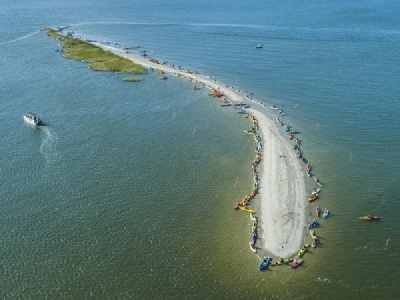
Posted on January 16, 2019
A year ago, restoring the once-thriving rookery that was Crab Bank was simply a dream without a source of financial reality. Now, the once seabird sanctuary will soon return thanks to federal financial aid. Coming down to the wire on its fundraising deadline, Crab Bank’s league of coastal conservatives received confirmation before the New Year that funding for the renourishment project was complete.
The lofty goal of $1.4 million, which seemed unattainable and insurmountable to its constituents at times, was achieved by a late push from the U.S. Water Resources Development Act (WRDA). In the days leading up to Christmas, South Carolina Department of Natural Resources (SCDNR) received the most timely gift of all in the form of a pilot program.
Early in 2018, the federal government announced a program under WRDA that would fund 10 projects supporting beneficial uses of dredged material. In March 2018, SCDNR submitted a proposal for this pilot program to cover 100 percent of the construction costs of restoring the Crab Bank. In late December, they were notified their proposal had been chosen as one of 10 successful pilot projects out of 95 applicants nationwide.
“We found ourselves in a position where we had gone through such an extensive fundraising campaign with such tremendous support from our community and then Crab Bank won the lottery,” said Caitie Forde-Smith, communications director of Coastal Conservation League. “We actually had the best of any problem ever, which is a lot of money. We are just totally flabbergasted.”
After a culmination of major contributions in 2018 from Moultrie Middle School, Boeing, National Fish and Wildlife Foundation and S.C. Ducks Unlimited totaling approximately $1.3 million, Crab Bank was in the homestretch of satisfying its goal by the end of the year. The indefinite amount from WRDA is guaranteed to offset the remaining $100,000 remaining plus the additional $3 million in federal funds to complete Charleston Harbor’s deepening.
The award of the WRDA funds means that 100 percent of the dredging and dumping of sand on Crab Bank will be covered. However, Forde-Smith says there are many “caveats” remaining as to when those funds will be made available to the Charleston District of the U.S. Army Corps of Engineers and if they award the contract in time for when the dredging occurs in 2019. These “unknown aspects” are largely in part of the government shutdown the U.S. is currently facing.
“This promise of WRDA funding is of course great news and a significant joy to us, but we don’t have the details of how much the final project estimate to restore Crab Bank will be,” Forde-Smith continued. “As you can imagine we’re still anxious and want to get these details worked out before claiming full victory but we are very confident Crab Bank will be restored in 2019.”
As of now, Crab Bank sits in a holding pattern, waiting for a “cash call” for the project’s total cost. The WRDA funding will “likely” be enough to cover the undisclosed lump sum. In the next few weeks, Forde-Smith says the Coastal Conservation League hopes to have answers to these missing details and unknowns.
If the WRDA funds arrive in time and cover the entire costs of construction, Crab Bank will be able to entertain stabilization options such as building oyster reefs. This was left out of the original cost-share option due to increased “unobtainable costs.”
“Either way, excitement for coastal bird conservation in South Carolina continues to build, and as each day passes, it appears that Crab Bank restoration is becoming more of a reality and less of a dream,” said Lorianne Riggin, SCDNR Office of Environmental Programs director.
Successful projects funded through the WRDA pilot program need to include goals such as: providing storm damage reduction; promoting public safety; protecting, restoring and creating aquatic ecosystems; promoting recreation; enhancing shorelines; civic improvement; and other innovative uses and dredge material placement alternatives that produce public economic or environmental benefits. Crab Bank meets all of the criteria.
Funds raised beyond this point will be put toward “extending the life of the project” long-range goals of protecting nesting and migrating birds along the entire S.C. Coast by increasing nesting success, building community awareness and adding to biologists’ knowledge about nesting behavior and reproductive success.
“We really owe it to the community. I really think it speaks to the awareness that our community has of what an amazing resource Crab Bank is and the benefits it provides beyond the ecological benefits,”Forde-Smith added. “It is a place our community recognizes that we can protect and we will do what we can to make sure that special places like Crab Bank are able to live on despite the changes we’re seeing in our region from a growth and development perspective.”
Source: Moultrie News





